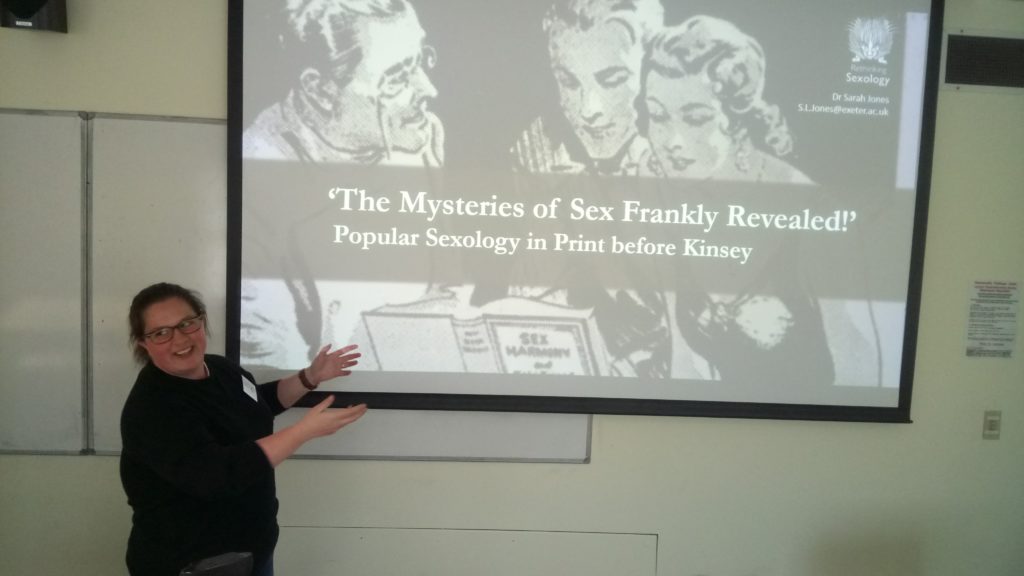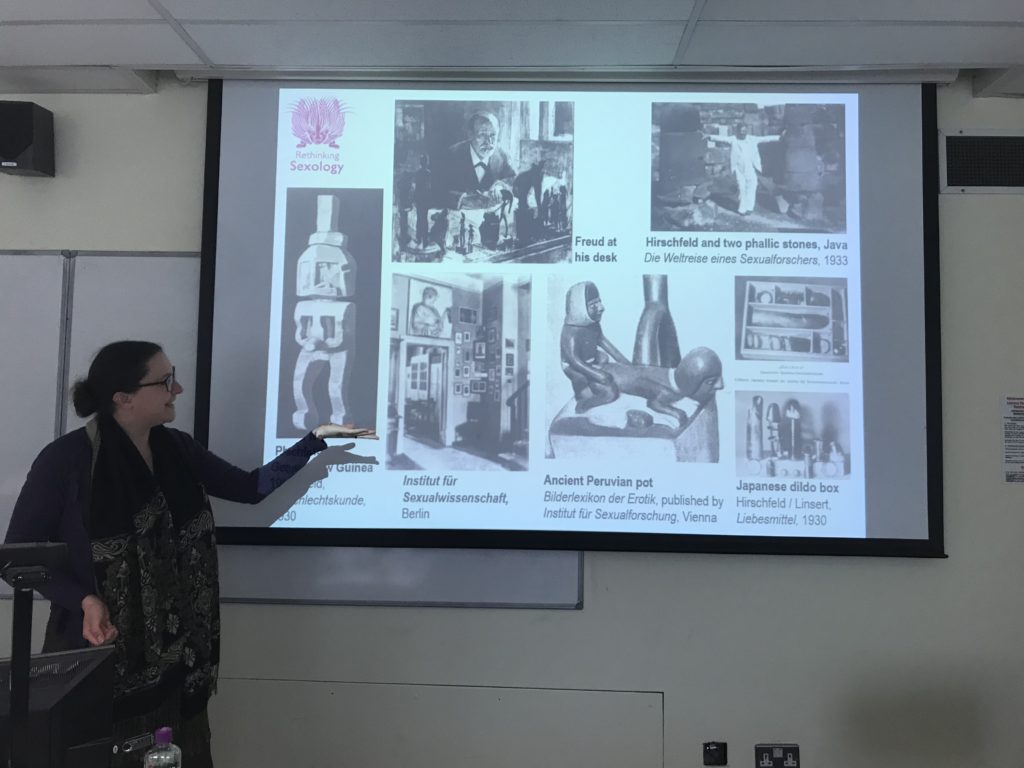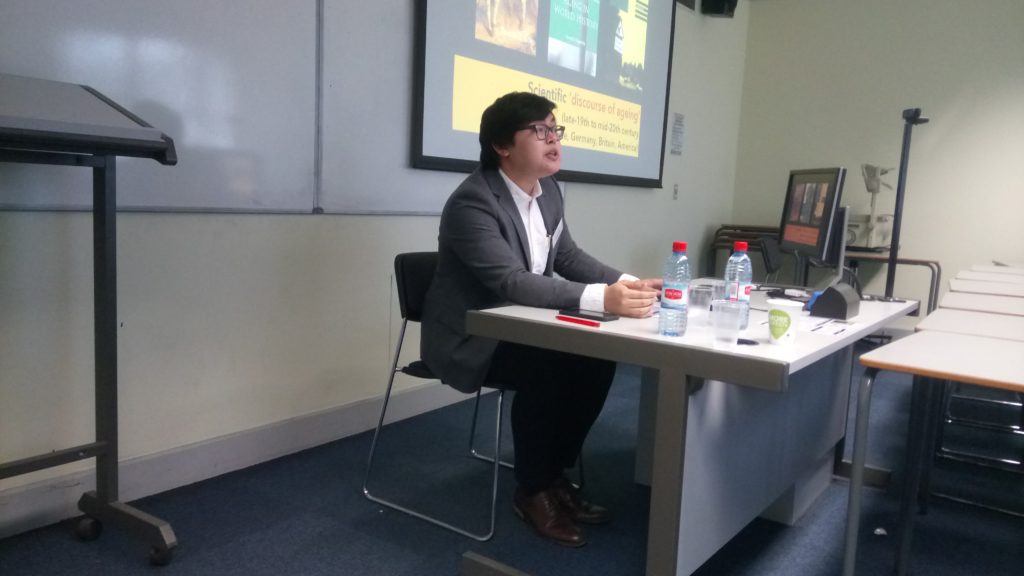The project delivered a special panel at the 32nd Irish Conference of Historians at University College Cork, April 2018. The theme of the conference was “Sex, sexuality & reproduction: historical perspectives”. The Rethinking Sexology team spoke on “New perspectives on sexual science (1890-1960)”.

Sarah Jones gave a paper on “‘The Mysteries of Sex Frankly Revealed!’: Popular Sexology in Print before 1940”.
 Jen Grove presented on “Sexologists as collectors of historical erotica in the first half of the twentieth century”.
Jen Grove presented on “Sexologists as collectors of historical erotica in the first half of the twentieth century”.
 Kazuki Yamada spoke on “Across sexology and gerontology: later life sexuality and medicine in historical perspective”.
Kazuki Yamada spoke on “Across sexology and gerontology: later life sexuality and medicine in historical perspective”.
Please see below for abstracts.
The study of the history of sexology is rapidly expanding. In recent years two major collections have in particular increased our understanding of the global development and exchange of sexological knowledge, by looking at the way in which “sexual science […] simultaneously emerged in multiple sites and […] took multiple shapes” (Fuechtner et al, A Global History of Sexual Science, 2018) and how the “intersections between national and transnational contexts, between science and culture, and between discourse and experience, shaped modern sexuality” (Bauer, Sexology and Translation, 2015).
This panel will consider further ways in which we might understand the complex and shifting conceptions of the “science” of sex from the late nineteenth to the mid-twentieth century. All three speakers on the proposed panel are early career researchers on a Wellcome-funded research project ‘Rethinking Sexology’ at the University of Exeter, which is seeking to reconsider the emergence of the scientific study of human sexuality. In particular its critiques the assumption that ‘sexology’ existed as a clearly understood and primarily medical field of knowledge.
Each paper in this panel will focus on a new or as yet undeveloped way of framing the history of sexology. Together they consider new audiences and producers of sexological knowledge; new legitimate forms of evidence for ‘scientific’ research outside of the ‘medical’; and new geographical locations for sexological activities that have been overlooked or undervalued in previous scholarship. The panel will seek to encourage a discussion about how historians define and set boundaries on ‘sexology’ and ‘sexual science’ – within the context of a conference considering the changing historicization of ‘sex’ and ‘sexuality’ more broadly – and consider the wider question of how knowledge and expertise around sex were conceived of in the late nineteenth century and the first half of the twentieth.
Individual papers:
‘The Mysteries of Sex Frankly Revealed!’: Popular Sexology in Print before 1940.
Dr Sarah Jones
Much of the existing research into the history of sexual science in the west has tended to focus on key sexological figures and the dissemination or appropriation of their scientific work. Particular attention has been paid to their work exploring the pathologies of perversion, and their attempts made to categorise and define non-normative sexual ‘types’. These histories, often centring on the work of men like Iwan Bloch, Havelock Ellis, and Magnus Hirschfeld, frequently take place in elite medical spaces – the hospital, the psychiatrist’s office, or the sexological institute.
But sexology had another life in the late nineteenth and early twentieth century. Through the pages of popular magazines like Sexology, Marriage Hygiene, and Physical Culture, through mass produced sex advice texts, and through the work of outspoken sex reformers, British and American publics were fed a steady diet of ‘thoroughly scientific’ information about issues surrounding sex and marriage. In this paper I will explore this popular sexology, dedicated to tips on achieving happy and healthy sex lives, as well as discussing what a good, normal marriage might look like. In doing so I will argue that scientific attempts to define the boundaries of ‘normal’ and ‘healthy’ sexuality at this time were not just being undertaken by an elite set of sexologists in medical spaces, but were also taking place amongst the producers and consumers of these popular texts.
Sexologists as collectors of historical erotica in the first half of the twentieth century.
Dr Jen Grove
Growing scholarly attention is being given to the way in which history, and especially the classical past, informed new sexological concepts in the late nineteenth and twentieth century. For instance, the publication of Sexual Inversion (1896/1897) by Havelock Ellis and Classical scholar John Addington Symonds, which drew on ancient Greek practices in order to defend contemporary male same-sex desire but also to think through the challenges of creating a paradigm which meant such desire could be treated as neither a disease nor a crime in Victorian society.
But as well as historical texts, many sexual scientists were significantly interested in material and visual culture from the past. It is well known that Sigmund Freud made use of his substantial collection of Egyptian and other ancient artefacts in his psychoanalytical theory and practice. But Magnus Hirschfeld and Alfred Kinsey were also avid collectors of historical erotic art and artefacts. This paper will consider what role physical evidence of historical sexual practices, desires and customs played in the study of sex and the method of comparing past and present cultures. How did displays of historical artefacts at sexological clinics, laboratories and other spaces of sexual science relate to sexology’s varied aims to research, educate, campaign and treat? And how did sexological concerns inform the wider acquisition of antiquities which was still growing the museums of Europe and America in this period? I will consider how the pursuit of collecting sat alongside the scientist’s work of gathering statistical and other types of data and by what mechanisms they sought to maintain scientific authority in the face of acquisitions of being collectors of antique “pornography” or “obscenity”. To what extent and how were diverse visual representations of sex from the past rationalised within the project of writing the “science” of sexuality?
Across sexology and gerontology: later life sexuality and medicine in historical perspective
Kazuki Yamada
If a large body of historical research has suggested the significant role late nineteenth and twentieth century Western sexual science has played in defining modern sexuality, it has not yet clarified this sexology’s relationship to describing and understanding sexuality in older age. Yet, sexology was not the only science interested in illuminating healthy and pathological relationships between sex and ageing. At the same time as sexual science began to establish itself in Europe and America, a nascent science of gerontology interested in all things ageing also began to emerge in similar geographic locations and time periods. Recognising recent strands of research that have highlighted sexology’s relationship with non-sexological fields of study, and how knowledges of sex were not exclusively produced within the remits of what historians have thus far defined as sexology, this paper argues that such flexibility around the ‘boundary work’ (Gieryn 1983) of sexual science is crucial towards a greater historical understanding of later life sexuality. I introduce the beginnings of a new research project that explicitly examines the historical convergences and divergences between sexology and gerontology in describing and understanding sexuality in older age. In doing so, I argue for the significance of a project which illuminates how sex was understood outside sexology, age understood outside gerontology, and how two scientific fields of study might interface in investigating a topic that cuts across both their remits. I also introduce some broader themes and key figures that serve as the preliminary narrative foundations of the project, such as the backdrop of eugenics, Freudian conceptualisations of sex-linked life course development, neurologist Jean-Martin Charcot, psychologist G Stanley Hall, sex reformer Marie Stopes, the sexual rejuvenationists of the 1920s, and researchers serving as interfaces between American sexology and gerontology.
For further details please see the conference website.
